With water being a finite resource, it’s essential to find sustainable ways to manage and conserve it. Rainwater harvesting is an eco-friendly water solution that can help you save money, promote sustainability, and achieve water independence.
By collecting and storing rainwater, you can reduce your reliance on municipal water sources and contribute to effective stormwater management. This article will explore the numerous benefits of rainwater harvesting for your home and provide insights into the different types of systems available.
Disclosure: When you buy through links on our site, we may earn an affiliate commission.
Key Takeaways
- Rainwater harvesting is an eco-friendly solution that can help with water conservation and management.
- By reducing reliance on municipal water sources, rainwater harvesting can promote water independence and save money on water bills.
- Effective stormwater management and mitigation of flooding, erosion, and pollution can be achieved with rainwater harvesting.
- Different rainwater harvesting systems are available, and the right choice will depend on individual needs and local regulations.
- Proper filtration and storage methods are crucial for ensuring rainwater is suitable for various uses.
Understanding Rainwater Harvesting Systems
When it comes to sustainable water management, rainwater harvesting is becoming an increasingly popular solution for homeowners. These systems capture rainwater from rooftop surfaces, which can then be stored and used for a variety of purposes, from irrigation to indoor use.

There are several different types of water harvesting systems available, each with its own unique components and method of operation. The most common systems include:
| Type of System | Description |
|---|---|
| Direct-Pumped System | This system pumps harvested rainwater directly into your plumbing system for use in toilets, washing machines, and outdoor irrigation. It’s the simplest and most cost-effective system to install. |
| Indirect Gravity-Fed System | This system involves collecting rainwater in a storage tank and using gravity to distribute the water through pipes to the desired location. It’s a reliable and low-maintenance system but requires a higher initial cost. |
| Indirect Pumped System | This system uses a pump to move rainwater from the storage tank to the point of use. It’s a flexible system that can be installed in a variety of locations and is ideal for larger properties. |
Whatever type of system you choose, it’s important to understand the process of collecting and storing rainwater. This typically involves installing gutters and downspouts on your rooftop to direct rainwater into a storage tank. From there, the water is filtered and treated to ensure it’s safe to use. Once the water is collected and treated, it’s ready for use in your home or garden.
By implementing a rainwater harvesting system, you can reduce your reliance on municipal water sources and promote sustainable water management. These systems can help you save money on water bills, reduce your environmental impact, and achieve a greater sense of water independence.
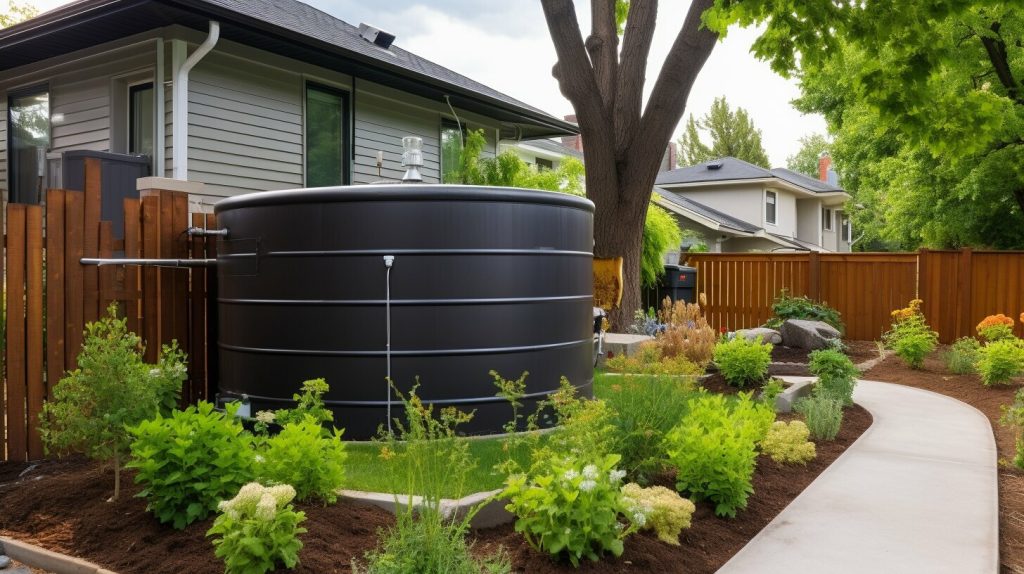
The Cost Savings of Rainwater Harvesting
When it comes to saving money on monthly bills, rainwater harvesting can be a wise investment. By collecting and storing rainwater, you can reduce your reliance on municipal water sources, leading to lower water bills and potential cost savings in the long run. Additionally, rainwater harvesting promotes water conservation, which can help preserve our natural resources and protect against future water shortages.
On average, a household of four can collect and store up to 50,000 gallons of rainwater per year. This figure may vary depending on your location, precipitation rate, and the size of your collection system. However, even a smaller system can help offset some of your household’s water needs and reduce your monthly water bill.
Cost savings aside, rainwater harvesting can also contribute to a healthier and greener lifestyle. By using rainwater for irrigation purposes, you can reduce your use of municipal water for landscaping, which can account for up to 30% of residential water use. Additionally, rainwater is free of the chemicals and additives commonly found in municipal water, making it a safer and healthier option for plants and soil.
| Cost Comparison | Monthly Water Bill | Annual Water Bill |
|---|---|---|
| Municipal Water | $50 | $600 |
| Rainwater Harvesting | $0 (with initial investment) | $0 (after initial investment paid off) |
As illustrated in the table above, the initial investment for a rainwater harvesting system can offset the cost of monthly and annual water bills, leading to significant long-term savings.
Implementing a rainwater harvesting system may also make you eligible for various incentives and rebates offered by local and state agencies. These incentives are designed to promote sustainable water management practices and can offset the initial costs of installation.
Overall, rainwater harvesting is a smart and eco-friendly solution for reducing your household’s water usage and saving money. With the potential for significant cost savings and a positive impact on the environment, it is a worthwhile investment to consider.
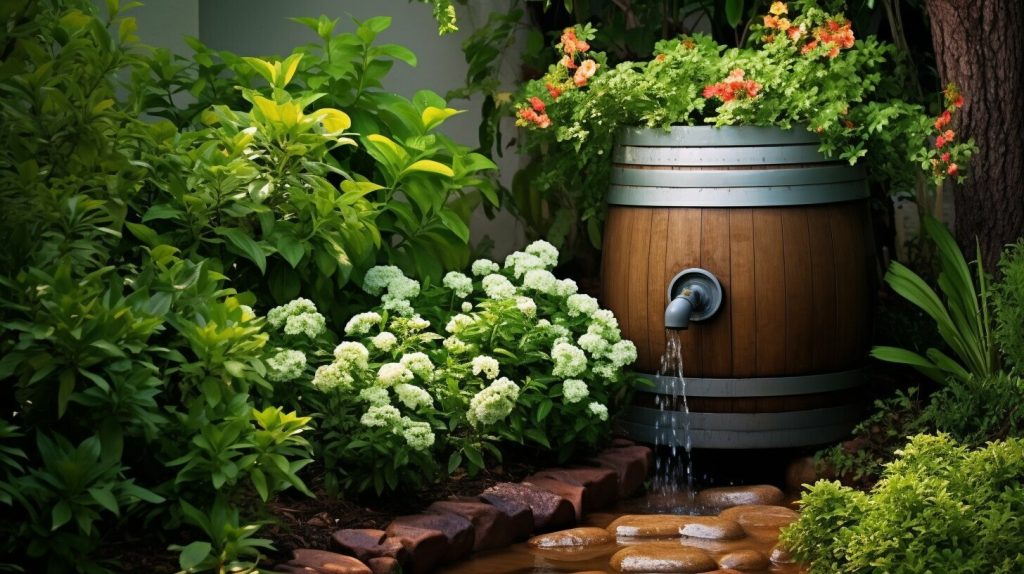
Environmental Benefits of Rainwater Harvesting
Rainwater harvesting systems not only offer economic benefits but also have a significant positive impact on the environment. Rainwater harvesting can contribute to effective stormwater management by reducing the amount of stormwater runoff that flows into municipal sewer systems. This decreases the risk of flooding, erosion, and other environmental damage caused by excess water flow.
In addition to mitigating stormwater runoff, rainwater harvesting systems also promote eco-friendly water solutions. Using collected rainwater for irrigation and other non-potable indoor uses reduces the reliance on municipal water supplies, conserving freshwater resources. This helps to ensure that the water supply is sustainable and accessible for future generations.
Furthermore, rainwater harvesting can improve water quality by reducing the amount of pollution and contaminants that enter waterways through stormwater runoff. This is particularly important in urban areas where frequent storms can cause significant damage to the environment.
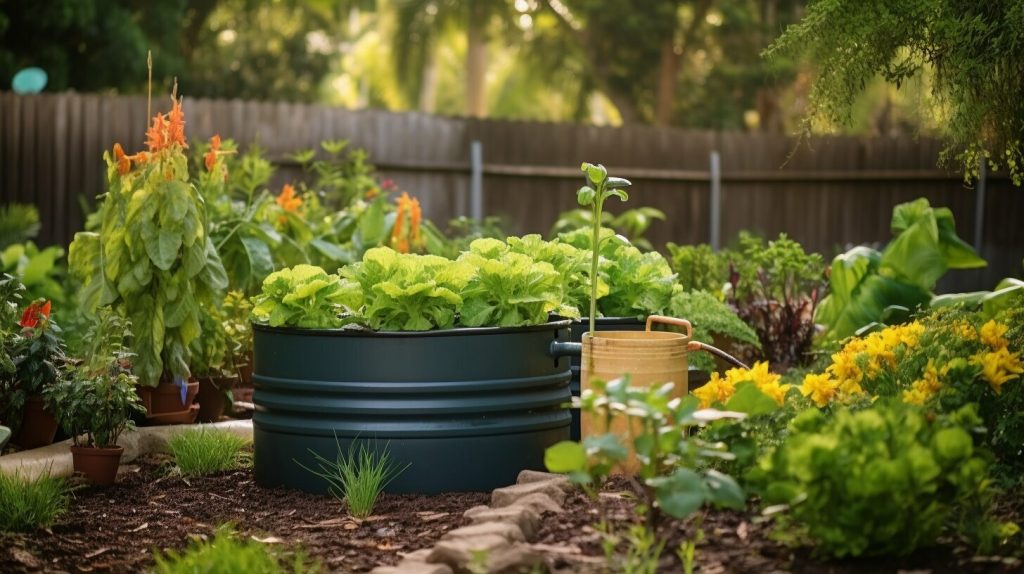
By implementing rainwater harvesting systems, individuals and communities can play an active role in promoting sustainable water management practices and reducing their environmental footprint.
Water Quality and Treatment
When it comes to water conservation and urban water management, understanding the quality and treatment of rainwater harvested is essential. Before utilizing rainwater for any purpose, it’s crucial to ensure that it’s free from pollutants and safe for use.
Proper filtration and treatment are necessary to remove any debris, bacteria, or other contaminants that may have been present in the collected rainwater. The use of a first flush diverter can help eliminate the initial flow of water that may contain any pollutants or contaminants.
The harvested water can then be filtered through a series of treatment systems, including sediment filters, biological filters, and disinfection systems, such as UV lights and chlorine. Investing in a high-quality filtration and treatment system can ensure that the collected rainwater meets the necessary standards for various uses, including indoor and outdoor applications.
Once the water has been treated, it can be safely stored in a well-maintained tank, ensuring that the water quality remains high. Regular maintenance and cleaning of the storage tank are essential for preventing any contaminants from entering the water supply.
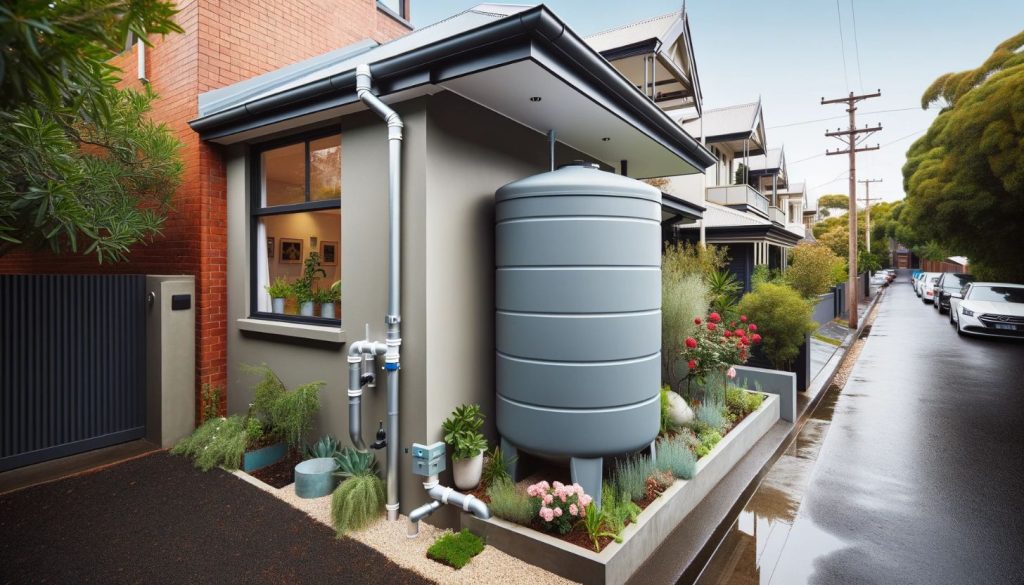
Implementing rainwater harvest systems is an environmentally friendly and sustainable way to conserve water and promote urban water management. Proper filtration and treatment methods can ensure that the collected rainwater is safe for use and help contribute to effective water conservation strategies.
Implementing Rainwater Harvesting Systems
If you’re considering implementing a rainwater harvesting system in your home, there are a few key steps to follow to ensure success.
Select the Ideal Collection Method
First, you’ll need to select the ideal method for collecting rainwater. The most common method is to use a gutter system to divert rainwater from your roof into a storage tank.
You’ll want to make sure that your gutters are properly maintained and free of debris to maximize the amount of water collected.
Consider installing gutter guards or screens to prevent leaves and other debris from clogging the system. This will make the process of collecting rainwater much more efficient and effective.
Choose the Right Storage System
Next, you’ll need to choose the right storage system for your needs. This will depend on how much rainwater you plan to collect and what you plan to use it for.
Storage tanks can range in size from small barrels to large underground tanks, and can be made of a variety of materials such as plastic, metal, or concrete.
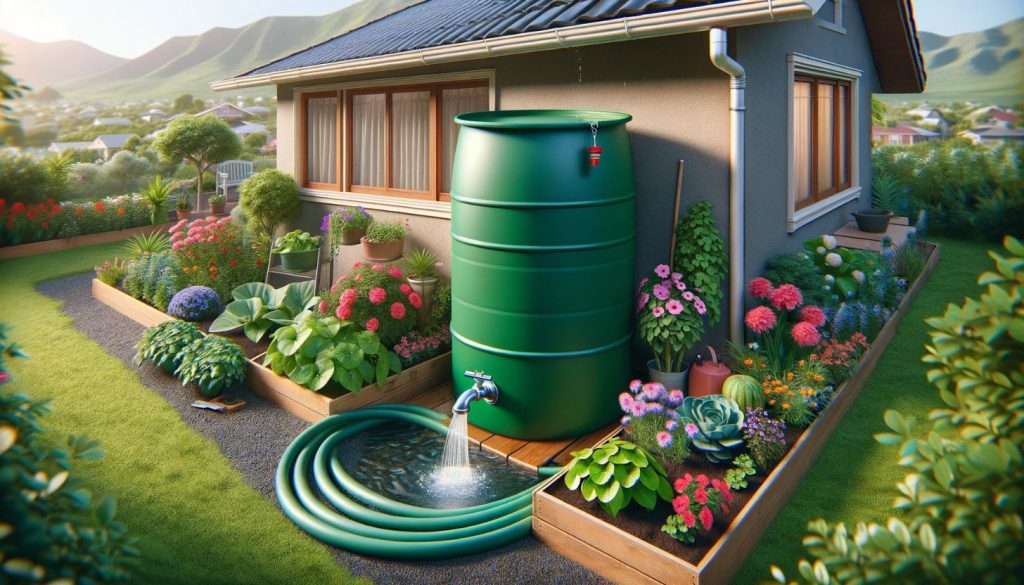
It’s important to choose a tank that is large enough to meet your needs but still fits in with the aesthetics of your property. You may also want to consider the location of the tank to maximize convenience and accessibility.
Integrate the System into Your Plumbing
Once you have your collection and storage systems in place, you’ll need to integrate the system into your plumbing to ensure that the collected water is properly distributed throughout your home.
You may need to hire a professional plumber to help with this step, as there may be some modifications needed to your existing plumbing system.
Make sure that the distribution system is set up to prioritize the use of rainwater over municipal water sources whenever possible, as this will help maximize your cost savings and overall sustainability.
Regular Maintenance and Upkeep
Finally, it’s important to keep up with regular maintenance and upkeep to ensure the longevity and optimal performance of your rainwater harvesting system.
This includes regular cleaning of the gutters and storage tanks, as well as ensuring that any filtration systems are properly maintained and replaced as needed.
By following these steps, you can successfully implement a rainwater harvesting system in your home and start enjoying the numerous benefits of this eco-friendly water solution.
Practical Applications of Rainwater Harvesting
Implementing a rainwater harvesting system in your home can offer a multitude of practical applications beyond just providing water for indoor and outdoor use. Let’s take a closer look at some of the common applications of water harvesting systems:
Irrigation
Using collected rainwater for irrigation purposes is a popular application of rainwater harvesting systems. Not only does it help to conserve water resources, but it can also reduce the strain on municipal water supplies during droughts or periods of high demand. Plus, rainwater is free of harsh chemicals and minerals found in tap water, which can be beneficial for plant growth and soil health.
Swimming Pool Maintenance
You can use rainwater for your swimming pool maintenance needs, such as filling the pool or topping up the water level. This can prove to be cost-effective in the long run, especially during the summer months when pools require regular maintenance.
Emergency Water Supply
In times of emergencies such as natural disasters or power outages, rainwater harvesting systems can provide a reliable backup source of water. Having a reserve of water can also prove to be essential in areas where water supply is scarce.
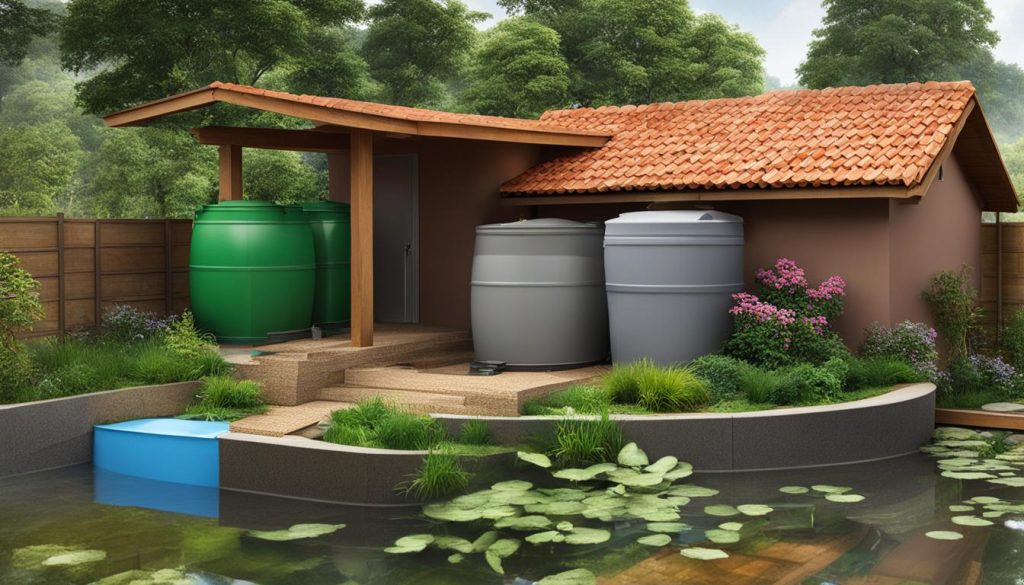
Stormwater Management
Rainwater harvesting systems can also help with effective stormwater management in urban areas. By collecting rainwater, less water ends up in storm drains, reducing the risk of flooding and erosion caused by excess water runoff.
Car and Window Washing
Instead of using tap water for washing your car or windows, consider using collected rainwater. This can help conserve water and reduce your utility bill.
Overall, rainwater harvesting systems offer many practical applications for homeowners looking to save money, conserve water, and contribute to sustainable water management practices.
Maintenance and Upkeep of Rainwater Harvesting Systems
Proper maintenance and upkeep of your rainwater harvesting system is necessary to ensure it operates effectively and efficiently. Here are some essential tasks to keep your system running smoothly:
- Regular Inspections: Check your system’s components and rainwater storage for signs of damage, leaks, or blockages. Inspect gutters, screens, and filters to ensure they are free of debris and working correctly.
- Cleaning: Regularly clean your rainwater storage to prevent sediment build-up and avoid potential contamination. Scrub the walls and floors of the tank, and flush the system before and after usage.
- Filter Replacement: Change or clean your filters periodically to ensure the water collected remains clean and suitable for use.
- Pump Maintenance: If your system has a pump, check it regularly to ensure it is functioning correctly. Clean the pump’s screen and replace or repair it if necessary.
Regular maintenance of your rainwater harvesting system not only ensures it works efficiently but also helps prevent potential health and safety risks. Additionally, proper upkeep promotes water conservation by minimizing the loss of stored rainwater through leaks or evaporation.
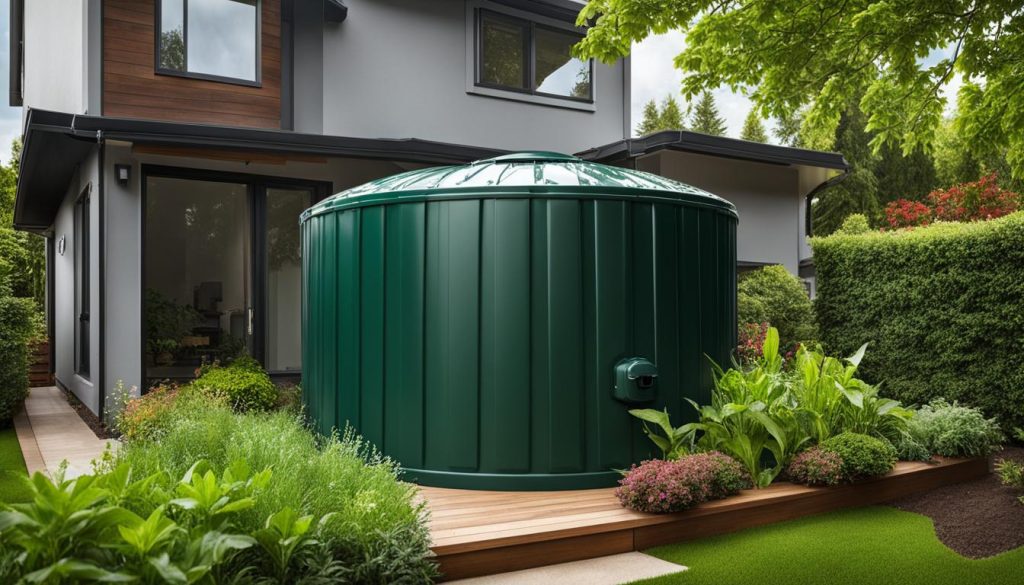
“Rainwater harvesting systems can last up to 20 years with proper maintenance and upkeep.”
By incorporating these routine maintenance tasks into your household upkeep, you can enjoy the benefits of your rainwater harvesting system for years to come. Additionally, consider consulting with a professional plumber to ensure your system functions optimally and complies with local regulations.
Regulations and Incentives for Rainwater Harvesting
As more homeowners turn to sustainable water management practices, local and state governments are taking notice. Many areas now offer incentives or rebates for the installation of rainwater harvesting systems. These programs aim to promote water conservation while reducing strain on municipal water sources.
Before installing a rainwater harvesting system, it’s important to check any local regulations or permits required. This may include restrictions on the size of the storage tank or the use of collected rainwater for certain purposes.
In addition to financial incentives, implementing a rainwater harvesting system can also contribute to meeting certain environmental regulations. For example, some areas require stormwater management practices that reduce the flow of runoff into local waterways. Rainwater harvesting can be an effective method in achieving these requirements.
By adopting sustainable water management practices like rainwater harvesting, you can not only save money on water bills but also contribute to a greener, more resilient future. Check with your local government to see if there are any available incentives or regulations that may apply to your home.

Conclusion
Implementing a rainwater harvesting system in your home not only promotes sustainable water management but also provides numerous benefits for you and your community. By collecting and storing rainwater, you can reduce your reliance on municipal water sources, saving you money on your water bills while conserving natural resources.
Properly filtered and treated rainwater can also be used for a variety of practical applications, such as irrigation and indoor water needs, reducing the strain on municipal water supplies. Additionally, rainwater harvesting can contribute to effective stormwater management, mitigating flooding, erosion, and pollution.
Remember that maintaining and upkeep of your rainwater harvesting system is essential to ensure it operates optimally and lasts for years to come. Make sure to regularly clean and maintain your storage tanks and components.
Lastly, be aware of the available regulations and incentives for rainwater harvesting in your area. Sustainable water management practices are becoming increasingly important, and implementing a rainwater harvesting system can help you do your part in creating a greener, more resilient future.
The benefits of rainwater harvesting are clear. Save money, promote sustainability, and achieve water independence by implementing a rainwater harvesting system in your home. Remember that every drop counts, and by conserving water, we can create a more sustainable future for all.
FAQ
What is rainwater harvesting?
Rainwater harvesting is the process of collecting and storing rainwater for various uses, such as irrigation, toilet flushing, and laundry. It involves capturing rainwater from roofs or other surfaces, filtering it, and storing it in tanks or cisterns for future use.
What are the benefits of rainwater harvesting?
Rainwater harvesting offers numerous benefits. It helps reduce reliance on municipal water sources, leading to potential cost savings on water bills. It promotes sustainability by conserving water and mitigating stormwater runoff. Plus, it provides a reliable water source during water shortages or restrictions.
How does rainwater harvesting contribute to water conservation?
Rainwater harvesting promotes water conservation by reducing demand for treated water from municipal sources. By using collected rainwater for non-potable purposes like irrigation, you’re conserving the treated water for essential uses.
Are there any specific regulations regarding rainwater harvesting?
Regulations regarding rainwater harvesting vary by location. Some areas have specific guidelines and permits in place for rainwater harvesting systems, while others may have no regulations at all. It’s important to check with local authorities or consult professionals to ensure compliance with any applicable regulations.
Can rainwater harvesting be implemented in urban areas?
Absolutely! Rainwater harvesting can be implemented in urban areas, often on a smaller scale. Urban rainwater harvesting systems can help manage stormwater runoff, reduce pressure on sewer systems, and provide a sustainable water source for various non-potable uses.
How is rainwater harvested water treated?
The treatment of harvested rainwater depends on its intended use. For non-potable uses, such as irrigation, basic filtration using screens and sediment traps may be sufficient. If the water is intended for potable use, additional treatment methods like disinfection and advanced filtration may be necessary.
What maintenance is required for rainwater harvesting systems?
Regular maintenance is essential for the optimal performance of rainwater harvesting systems. This includes inspecting and cleaning gutters, downspouts, and filters, as well as monitoring the condition of storage tanks or cisterns. It’s also important to check for any leaks or blockages and ensure the system is functioning properly.
Are there any incentives or rebates available for rainwater harvesting systems?
Some regions offer incentives or rebates for implementing rainwater harvesting systems as part of their sustainable water management programs. These incentives can vary, so it’s advisable to research local programs or check with your municipality to see if any financial assistance or rebates are available.




